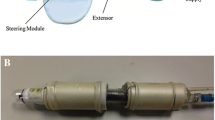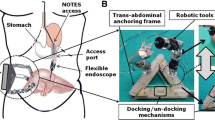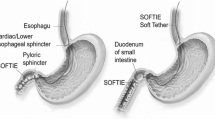Abstract
Background
The state-of-the-art technology for gastrointestinal (GI) tract exploration is a capsule endoscope (CE). Capsule endoscopes are pill-sized devices that provide visual feedback of the GI tract as they move passively through the patient. These passive devices could benefit from a mobility system enabling maneuverability and controllability. Potential benefits of a tethered robotic capsule endoscope (tRCE) include faster travel speeds, reaction force generation for biopsy, and decreased capsule retention.
Methods
In this work, a tethered CE is developed with an active locomotion system for mobility within a collapsed lumen. Micro-patterned polydimethylsiloxane (PDMS) treads are implemented onto a custom capsule housing as a mobility method. The tRCE housing contains a direct current (DC) motor and gear train to drive the treads, a video camera for visual feedback, and two light sources (infrared and visible) for illumination.
Results
The device was placed within the insufflated abdomen of a live anesthetized pig to evaluate mobility performance on a planar tissue surface, as well as within the cecum to evaluate mobility performance in a collapsed lumen. The tRCE was capable of forward and reverse mobility for both planar and collapsed lumen tissue environments. Also, using an onboard visual system, the tRCE was capable of demonstrating visual feedback within an insufflated, anesthetized porcine abdomen.
Conclusion
Proof-of-concept in vivo tRCE mobility using micro-patterned PDMS treads was shown. This suggests that a similar method could be implemented in future smaller, faster, and untethered RCEs.







Similar content being viewed by others
References
Given Imaging Ltd (2011) Overview of products. Available at http://www.givenimaging.com/en-us/HealthCareProfessionals/Pages/pageHCP.aspx. Accessed 6 April 2011
Cave D, Legnani P, de Franchis R, Lewis BS (2005) ICCE consensus for capsule retention. Endoscopy 37(10):1065–1067
Liao Z, Gao R, Xu C, Li ZS (2010) Indications and detection, completion, and retention rates of small-bowel capsule endoscopy: a systematic review. Gastrointest Endosc 71(2):280–286
Beutel RG, Gorb SN (2001) Ultrastructure of attachment specializations of hexapods (Arthropoda): evolutionary patterns inferred from a revised ordinal phylogeny. J Zool Syst Evol Res 39(4):177–207
Beutel RG, Gorb SN (2006) A revised interpretation of the evolution of attachment structures in hexapoda with special emphasis on Mantophasmatodea. Arthropod Syst Phylog 64(1):3–25
Gorb S (2000) Biological microtribology: anisotropy in frictional forces of orthopteran attachment pads reflects the ultrastructure of a highly deformable material. Proc R Soc Lond B Biol Sci 267(1449):1239–1244
Gorb SN (2011) Attachment devices of insect cuticle. Springer, New York
Persson BN, Gorb SN (2003) The effect of surface roughness on the adhesion of elastic plates with application to biological systems. J Chem Phys 119(21):11437–11444
Karagozler ME, Cheung E, Kwon J, Sitti M (2006) Miniature endoscopic capsule robot using biomimetic micro-patterned adhesives. In: Proc. IEEE/RAS-EMBS international conference on biomedical robotics and biomechatronics, pp 105–111
Cheung E, Karagozler ME, Park S, Kim B, Sitti M (2005) A new endoscopic microcapsule robot using beetle inspired microfibrillar adhesives. In: Proc. IEEE/ASME international conference on advanced intelligent mechatronics, pp 551–557
Glass P, Cheung E, Sitti M (2008) A legged anchoring mechanism for capsule endoscopes using micropatterned adhesives. IEEE Trans Biomed Eng 55(12):2759–2767
Buselli E, Pensabene V, Castrataro P, Valdastri P, Menciassi A, Dario P (2010) Evaluation of friction enhancement through soft polymer micro-patterns in active capsule endoscopy. Measure Sci Technol 21(10):105802-1–105802-7
Valdastri P, Webster RJ, Quaglia C, Quirini M, Menciassi A, Dario P (2009) A new mechanism for mesoscale legged locomotion in compliant tubular environments. IEEE Trans Robotics 25(5):1047–1057
Sliker LJ, Wang X, Schoen JA, Rentschler ME (2010) Micropatterned treads for in vivo robotic mobility. J Med Devices 4(4):041006-1–041006-8
Ntziachristos V, Chance B (2000) Probing physiology and molecular function using optical imaging: applications to breast cancer. Breast Cancer Res 3(1):41–46
Acknowledgments
The authors acknowledge the Colorado Nanofabrication Lab (CNL), a member of the National Nanotechnology Infrastructure Network, which is supported by the National Science Foundation (grant ECS-0335765). This publication was made possible in part by funds from the University of Colorado Innovative Seed Grant Program, the University of Colorado Undergraduate Research Opportunities Program (UROP), and the University of Colorado Discovery Learning Apprenticeship (DLA) program. This work was also funded in part by a Junior Faculty Pilot Award from the Colorado Clinical and Translational Sciences Institute (CCTSI) and supported by NIH/NCRR Colorado CTSI Grant Number UL1 RR025780. Levin Sliker is a National Science Foundation (NSF) Graduate Research Fellow.
Disclosures
Drs. Schoen and Rentschler, Mr. Sliker, and Ms. Kern have no conflicts of interest or financial ties to disclose.
Author information
Authors and Affiliations
Corresponding author
Rights and permissions
About this article
Cite this article
Sliker, L.J., Kern, M.D., Schoen, J.A. et al. Surgical evaluation of a novel tethered robotic capsule endoscope using micro-patterned treads. Surg Endosc 26, 2862–2869 (2012). https://doi.org/10.1007/s00464-012-2271-y
Received:
Accepted:
Published:
Issue Date:
DOI: https://doi.org/10.1007/s00464-012-2271-y




